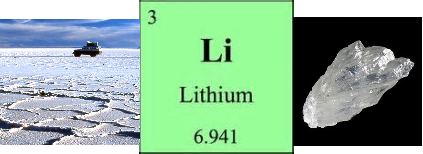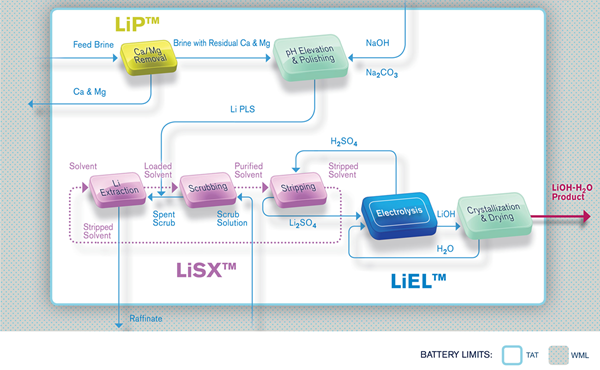Source: http://aheadoftheherd.com/Newsletter/2011/Brine-Mining-for-Potash-and-Lithium.htm
* Enirgi Group Corporation announced in 2014 a new proprietary lithium extraction technology that produces lithium directly from raw brine at commercial volumes; radically reduces processing time from the conventional 500+ days to less than 24 hours. It totally eliminates the need for capital intensive mega-evaporation pond infrastructure.
* ERAMET has also developed an innovative Direct Extraction Process to extract the lithium contained in the brine; this process is lower-cost and more environmentally-friendly than the conventional evaporation method of obtaining lithium. The proprietary technology was developed by ERAMET’s leading Research and Development Center, ERAMET Research (based near Paris, France) in partnership with the French Petroleum and Renewable Energy Institute (IFP Energies Nouvelles).
POSCO (NYSE:PKX) has developed their own secretive lithium extraction technique, since 2010, possibly using leaching. It is reported to have an 80-90% lithium recovery rate when using it on brine, and taking just 8 hours. POSCO commissioned a 2,500 ton per year lithium carbonate plant early 2017 at its Gwangyang Works plant in Korea and is anticipated to help supply its battery making partners LG Chem and Samsung SDI, as well a subsidiary company that produces cathodes for secondary batteries.
* Tenova Bateman has developed a lithium "solvent extraction" technology they call "LiSX". LiSX technology achieved spectacular results at bench scale with 100% Lithium extraction at robust purity, lithium chloride solution (>99.9%), in just 1 day. Tenova are currently working with several lithium miners such as Pure Energy (HMGLF) (NYSE:PE), Orocobre (OTCPK:OROCF) (ASX:ORE), and Lithium Americas (OTCQX:LACDF) [TSX:LAC].
* Neometals (OTC:RRSSF) (NYSE:NMT) has developed the ELi Process. The ELi process converts spodumene concentrate into a high purity lithium chloride solution, then uses "electrolysis" to produce high purity lithium hydroxide and lithium carbonate. Put simply the plant takes in lithium ore or brine, adds hydrochloric Acid (HCl)), then using electrolysis splits the compound to separate out the lithium to form lithium hydroxide.
* Nemaska Lithium (OTCQX:NMKEF) [TSX:NMX] have stated they estimate their cost of lithium hydroxide production will be very competitive at USD 2,154/tonne also using electrolysis.
- IBC Advanced Technologies, Inc. is to utilize their proprietary metals separation technology, known as Molecular Recognition Technology (“MRT”) for selective lithium extraction. Lithium Energi Exploration Incorporated is finalizing plans to construct a small, but commercial-scale plant that will produce either Li carbonate or hydroxide at a rate of 1,000 metric tonnes /yr.
- Membrane Development Specialists has developed new membrane technologies enabling the recovery of lithium from lithium clay. Due to the dilute lithium concentration of clays, achieving efficient recovery is quite challenging. MDS’ patent-pending process involves acid digestion of clays with proprietary NF, ultrafiltration (UF) and reverse-osmosis (RO) membrane processes.
A study, undertaken by South Africa’s Synexus using raw brine from the Salar de Llullaillaico location of Mariana, indicates that the selective recovery of lithium directly from raw (filtered) brine, with the simultaneous rejection of other cation and anion species, using a proprietary lithium selective separation process, is possible.
Processing plants at Greenbushes Mine, Australia
The two lithium plants receive crushed ore from a four stage crushing plant. The ore is then taken to the ROM pad where it is stockpiled according to ore type, mineralogical characteristics and grade. The technical grade plant is fed with lithium ore types in which the iron content of the spodumene is sufficiently low to enable production of higher grade lithium concentrates containing low levels of Fe2O3. Crushed ore is fed by front-end loader from stockpiles to a feed bin from which it is discharged at a rate of between 27 tph and 30 tph to the wet grinding circuit. The grinding circuit comprises two ball mills closed by 700 µm aperture vibrating screens, which produce material ground to 80% finer than approximately 450 µm. Ground technical grade feed is treated in a series of gravity, magnetic separation and flotation stages to produce the range of technical grade concentrates before these are filtered and dried. The concentrate contains around 94% spodumene. The chemical grade plant is fed with ore in which the iron content of the spodumene is too high to produce lithium concentrates meeting the specifications of technical grade plant products. Chemical grade ore is processed at a rate of 160 tph through milling to 3mm and processing by gravity separation and flotation. The chemical grade product is filtered and transported for bulk shipment.
Lithium Australia NL ASX:LIT believes disruptive lithium chemical production will power the energy revolution that is transforming the world as we know it. To that end, the Company has developed SiLeach™, an exclusive technology that can process all lithium silicates into battery-grade materials without the need for ‘roasting’.


